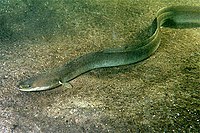
Photo from wikipedia
The European eel (Anguilla anguilla) is Critically Endangered under the International Union for Conservation of Nature (IUCN) Red List Categories and Criteria because it has markedly declined in abundance across… Click to show full abstract
The European eel (Anguilla anguilla) is Critically Endangered under the International Union for Conservation of Nature (IUCN) Red List Categories and Criteria because it has markedly declined in abundance across all life-history stages in much of its natural range. Barriers to migration, such as weirs and sluices, that prevent access to upstream habitat are a key threat to eels in freshwater systems. The impact of these barriers can be partially mitigated by the installation of eel passes that restore migratory pathways. In the Thames River Basin District (Thames RBD), The Zoological Society of London (ZSL) and partners have added traps to monitor eel passes. Further, these organizations have developed a network of citizen scientists and stakeholder organizations that monitor eel movement through the passes. In this paper, we review how data from the Thames European Eel Project enables a better understanding of eel ecology in the Thames RBD and how these data can inform conservation management decisions. In addition, we ask whether stakeholder engagement via citizen science has informed effective conservation action for this species.
Journal Title: Freshwater Science
Year Published: 2019
Link to full text (if available)
Share on Social Media: Sign Up to like & get
recommendations!